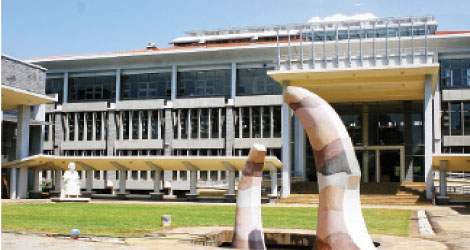 |
|
Catholic University of Eastern Africa's Learning Resource Centre. |
When the green building category was added to the Energy Management Awards, only nine buildings met the criteria set. PETER MUIRURI tells you which ones did and why
The Green Building Award category sought to recognise buildings that met the environmental design criteria. Only nine made the cut.
9. Leven House, Mombasa
Located in Mombasa’s old town, the building got its name from a British naval ship, the HMS Leven that visited the island in 1824. The building was rented by officers from the ship for use as an anti-slavery base.
After renovations co-ordinated by the Mombasa Old Town Conservation Office and the Museums of Kenya, the building was reoccupied in 2010.
The panel said it is optimally oriented for the coast climate with major window facades in the North and South facing walls. It has light coloured walls with high thermal mass for cooling. It also uses local materials and technology and a natural ventilation system.
8. Manda Airport, Lamu
Designed by Adventis Inhouse Africa, the terminal building uses solar photovoltaic panels and is perhaps the only terminal building that is fully solar powered.
It uses locally available materials, has natural ventilation and lighting system, light coloured walls with high thermal mass for cooling and a wastewater recycling technology.
7. Uaso Nyiro Primary School
Located in Segera, Laikipia, the school has been voted as one of the two greenest in the world by the US Green School Building Council. The other one is in Hong Kong. Uaso Nyiro School has been hailed for its water harvesting techniques in a semi-arid area. Each year, the school collects 350,000 litres of water that is then filtered using a clay-based system and is stored through an underground storage tank. Also included in the design are natural ventilation and lighting systems and a permeable landscaping and green areas throughout the building.
6. Red Pepper House, Lamu
It is considered one of the well designed on the East African coast. Designed by Urko Sanchez Architects, its makuti roof blends well with the surroundings.
Much of the space inside has no walls, allowing guests to take in much of the tropical climate. It is optimally oriented for the climate with the major window facades in the North and South facing walls. Large shaded areas provide cooling to internal spaces while solar photovoltaic panels provide water heating and other power related activities.
With extensive use of locally available and recyclable materials, the design has little interference with surrounding fragile landscape and vegetation.
Stay informed. Subscribe to our newsletter
5. Strathmore University, Phase III
Designed by Lexicon Architects, the building is oriented for the climate with the major window facades in the North and South facing walls thus preventing excess glare to the users.
There is sun shading on all windows. Natural lighting and ventilation, high thermal mass walls and a natural cooling tower are among the facilities that catapult this building to the top five.
The architecture employs an energy efficient building management system. Rain water harvesting, waste water recycling technologies and a permeable landscape, light colour on the exterior reflects solar radiation and reduces heat gain to the building.
4. Unep Building, Nairobi
It has been touted as one of the greenest buildings globally and houses Unep and UN-Habitat headquarters as part of the UN Greening the Blue Initiative.
It features automated low-energy lighting workspaces, water saving taps and lavatories, energy efficient computers and rainwater harvesting. It also has a central atrium and light wells in all office zones as well as an inventive design that maximises cooling natural airflow throughout the building.
3. Oleleshwa Primary School, Ewaso Ng’iro
The school’s design by Geoffrey Wasonga has incorporated the cultural heritage of the local Maasai community. Completed in 2013, the school incorporated climatic considerations with the major window facades in the North and South facing walls, thus preventing excess glare to the pupils.
The Maasai hut design has large shaded areas, natural lighting and ventilation, rainwater harvesting and wastewater recycling technology as well as use of local and recyclable materials.
2. Coca Cola East and Central Africa Business Unit, Nairobi
Viewed from above, the ultra modern building in Upper Hill, Nairobi, forms the company’s ‘C’ shaped logo.
Designed by Triad Architects (Kenya) in collaboration with GAPP Architects & Urban Designers (South Africa), it has wide, clear windows with a north-south orientation to allow natural lighting filter in, while keeping direct heat away and eliminating the need for mechanical air conditioning system.
Rainwater harvesting techniques with a capacity to hold 50,000 litres of water have been included while a rooftop lawn reduces heat gain, making the building cooler most of the day.
Photo-sensor lights at the driveway that turn on only at night eliminate the chance of leaving them on during the day. A lighting system near windows is also fitted with photo sensors to enable them switch off automatically once they detect ample external lighting during the day.
1. Learning Resource Centre, Catholic University of Eastern Africa
Designed by Architect Musau Kimeu, LRC was completed and occupied in 2012. It comprises a modern conference hall, a bookshop, an extensive library and a cafeteria.
The conference hall employs an intricate cooling system where air gets in through vents located at the basement level, passes over well arranged bedrock where it cools further before being released into the auditorium through another set of vents.
This is the only rock bed cooling system in Kenya. To expel foul air, thermal chimneys are located at various intervals of the building. There are oxidation ponds for sewerage.
A high-roofed atrium with a narrow plan allows natural lighting to filter through the building. To prevent heat buildup in glazed areas, concrete fins and aluminum louvre screens have been used
It is also oriented for the climate with the major window facades in the North and South facing walls preventing excess glare to the users.
 The Standard Group Plc is a
multi-media organization with investments in media platforms spanning newspaper
print operations, television, radio broadcasting, digital and online services. The
Standard Group is recognized as a leading multi-media house in Kenya with a key
influence in matters of national and international interest.
The Standard Group Plc is a
multi-media organization with investments in media platforms spanning newspaper
print operations, television, radio broadcasting, digital and online services. The
Standard Group is recognized as a leading multi-media house in Kenya with a key
influence in matters of national and international interest.
 The Standard Group Plc is a
multi-media organization with investments in media platforms spanning newspaper
print operations, television, radio broadcasting, digital and online services. The
Standard Group is recognized as a leading multi-media house in Kenya with a key
influence in matters of national and international interest.
The Standard Group Plc is a
multi-media organization with investments in media platforms spanning newspaper
print operations, television, radio broadcasting, digital and online services. The
Standard Group is recognized as a leading multi-media house in Kenya with a key
influence in matters of national and international interest.






